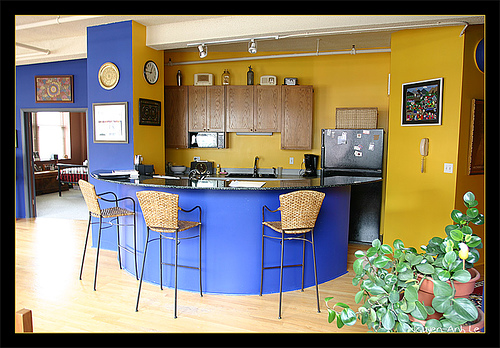Ask Brian is a weekly column by Real Estate Expert Brian Kline. If you have questions on real estate investing, DIY, home buying/selling, or other housing inquiries please email your questions to askbrian@realtybiznews.com.

Question from Molly: Hi Brian, our family of three lives in a 35 year old house that still has a kitchen from the 1980s. We want to redo the entire kitchen ourselves but for budget reasons, we need to do it a little at a time. What do you think is a good phased approach for a full kitchen remodel?
Answer: Hello Molly. You guys have decided to tackle the type of DIY project that has been known to strain a marriage so keep that in mind as you get started. The good news is that a phased approach will not only be easier on your budget but probably on your relationship as well. Right from the beginning, you should consider which part of your kitchen you’ll miss the most while it’s torn apart but you might be in for a surprise. If you think going a couple of days or a week without a stove is what you’ll miss the most, think about what it’s going to be like without a deep kitchen sink to stack dishes in. During a major kitchen project, the dishes have a way of stacking up in the sink because after dinner and a hard workday, dishes are the last thing anyone wants to tackle. Especially, when doing the dishes is a pain in the you-know-what. Without a dishwasher or kitchen sink, you’ll be grateful if you have a utility room sink. Otherwise, you’re likely to be on your knees doing dishes in a bathtub or old fashion washtub in the backyard. So pay particularly close attention to the planning phase for the kitchen sink, dishwasher, countertops and any disruption to the plumbing.
With the kitchen sink problem in mind, let’s take a look at a good phased approach to planning the kitchen remodel. Here is the tier one approach you want to start with:
- Design phase
- Budget phase
- Planning/scheduling phase
- Upper cabinets phase
- Lower cabinets and countertop phase
- Appliance phase
- Flooring phase
- Finishing touches phase
Maximize your budgeting and planning phase to create the dream kitchen that you want. You can plan this project over the next five months or the next five years. A long-term phased plan allows you to pay as you go instead of taking out a second mortgage to do everything at once. It also means you can schedule it to minimize the disruption of your daily routines.
Design phase. Your goal is a high-level design that paints the picture of what your kitchen will look like when finished. Before you start deciding on color choices, you should be thinking about functionality. How high do you want the top cabinet shelf, what’s the best layout for the appliances, and what height do you want the counters at? For instance, do you want the new overhead cabinets to go all of the way to the ceiling or do you want these lower on the wall so you can put bulky and seldom-used items on top of the cabinets? One option is having closed cabinets go all of the way to the ceiling with an open plate rack below. But then you should think about the headroom between the countertop and the lowest shelf. Lots of choices and decisions go into the design phase.
Budget phase. Budgeting and planning need to work together so that you have the needed funds for each scheduled phase. However, getting started with budgeting is simpler when you group costs into categories. Logical categories are cabinets, appliances, flooring, plumbing work, electrical work, countertops, and fixtures. Budgeting is when you decide on cost limits such as custom made or prefabricated cabinets. Top-end or midrange appliances. When you start putting prices on everything, think about how long you’re phasing the entire project. You’ll need to include more price inflation for a five-year project than for a five-month project. Also, price in any specialty tools you’ll need for electrical, plumbing, tile, or woodwork. It’s always a good idea to bump up costs by 10% to 20% to account for the unexpected or changes in plans. In addition to categorizing your budget, build it line-by-line so that you can pull the individual line costs into the planning/scheduling phase.
Planning/scheduling phase. By now, you should have decided if you are trying to complete this big project in five months or five years. This is where you plan the dates that you’ll start demolishing your kitchen and when you’ll have parts of it put back together. Obviously, you don’t want to tear something apart when you don’t have the time or the money to put it back together. The phased approach lets you minimize the disruption. Generally, you want to start from the top and work down. You can probably rip out the overhead cabinets in one weekend and put the new ones up in another weekend or two, assuming you don’t have to tear out walls to upgrade the electrical or plumbing.
When you tear out the lower cabinets is when you start the major disruption because the countertops and sink come out also. This is when you seriously want to think about what else is going on in your home and life. Do you want this major disruption when the kids in school or out of school? Do you want to do it when you have out of town guests visiting or right before the holidays? Also, think about any other time commitments that will slow down your reconstruction work. This is also a good time to make sure your budget can handle several take-out meals.
Upper cabinet phase. The physical work begins. It’s probably the easiest phase of construction, which makes it a good place to start learning how the family will deal with minor disruptions. Still, the disruptions can be significant if you need to rip out sheetrock to run a new electrical wire for an under cabinet light or above stove exhaust vent. You can also expect to do sheetrock work if the new cabinets are a different size or in a different location. Make sure you plan and schedule every detail.
Lower cabinets and countertop phase. This is the biggie that has already been mentioned for the disruptive impact that it has. This when you’re most likely not going to be able to use the kitchen for a couple of weeks or longer. You may need to have custom cabinets and countertops made to fit the new appliances coming in the next phase. Often, custom countertop measurements can’t be finalized until the cabinet bases are completely installed. And before installing the cabinet bases is the time when most plumbing and electrical work requires sheetrock be removed. Details, details, details. It’s not unusual for this phase to take two months if you’re doing it alone on the weekends.
Appliance phase. This is typically the most expensive phase. Something to think about is making these purchases before doing all of the cabinet work if your phased schedule goes out for a couple of years. Custom cabinets need to be exactly measured to fit appliances. You don’t want the appliances you measured to be discontinued after you have the cabinets and countertops installed. The phased approach also lets you buy appliances during sales. Make sure you’ve carefully planned for any electrical or plumbing changes that will be needed.
Flooring phase. This is another phase that needs to carefully consider the appliances and even the overhead cabinets. If you are going to be adding a tile or wood floor, it will add some height to the floor. That extra floor thickness may need to be considered where the refrigerator slides in under an overhead cabinet. But the good news is that flooring is one of the least disruptive phases. Depending on the square footage of the floor, it can usually be completed in one or two weekends even when working by yourself.
Finishing touches phase. Finally, the least disruptive phase that can almost be done at your leisure. This might be a decorative tile backsplash around the countertops or window treatments. It could also be replacing an old overhead light fixture. If you’ve overrun your budget elsewhere, you can easily postpone these purchases until you have the cash. After all the hard work you’ve been doing, you might even want to wait until your brother-in-law comes to visit and put him to work one Saturday.
Molly, I hope this helps. The phased approach gives you a lot of flexibility but still takes detailed planning. If you’re not too busy with your remodel, send an occasional update about how it’s going and any lessons you learn that will help others.
Please share your comments about what you’ve learned from a DIY kitchen remodel.
Our weekly Ask Brian column welcomes questions from readers of all experience levels with residential real estate. Please email your questions or inquiries to askbrian@realtybiznews.com.

Author bio: Brian Kline has been investing in real estate for more than 35 years and writing about real estate investing for 12 years. He also draws upon 30 plus years of business experience including 12 years as a manager at Boeing Aircraft Company. Brian currently lives at Lake Cushman, Washington. A vacation destination, near a national and the Pacific Ocean.
The post Ask Brian: How to Use a Phased Approach for a Major Kitchen Remodel appeared first on RealtyBizNews: Real Estate News.

